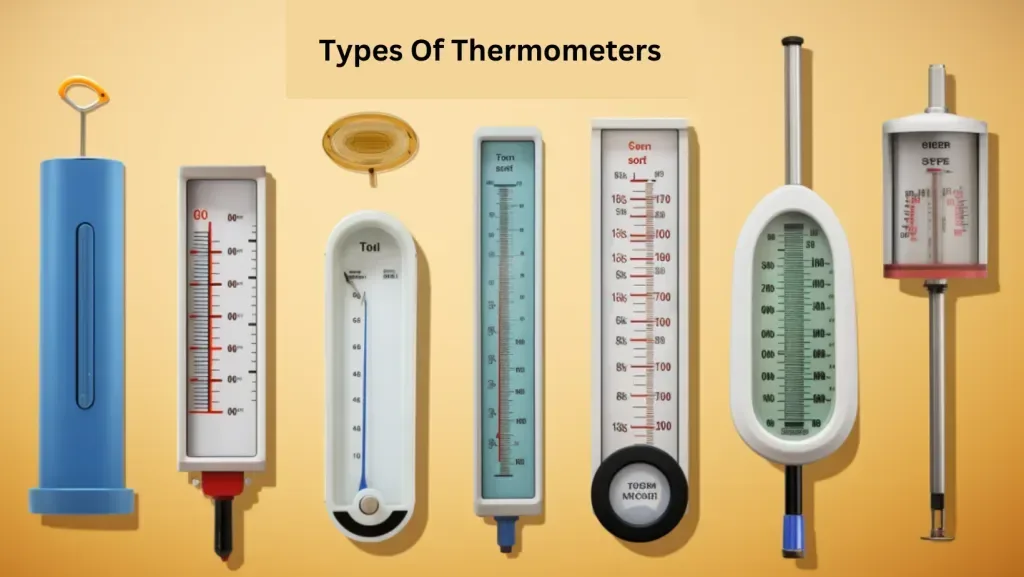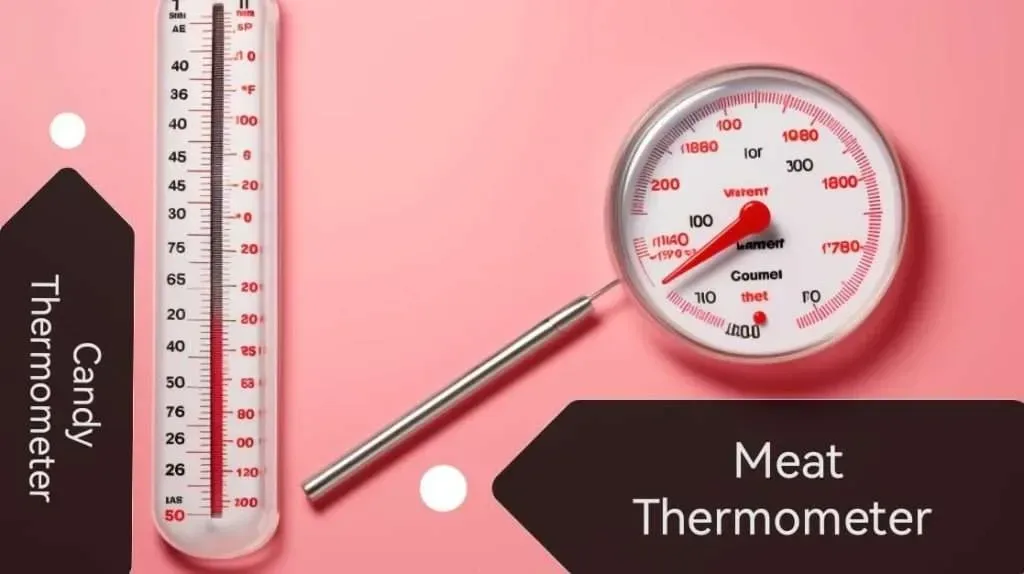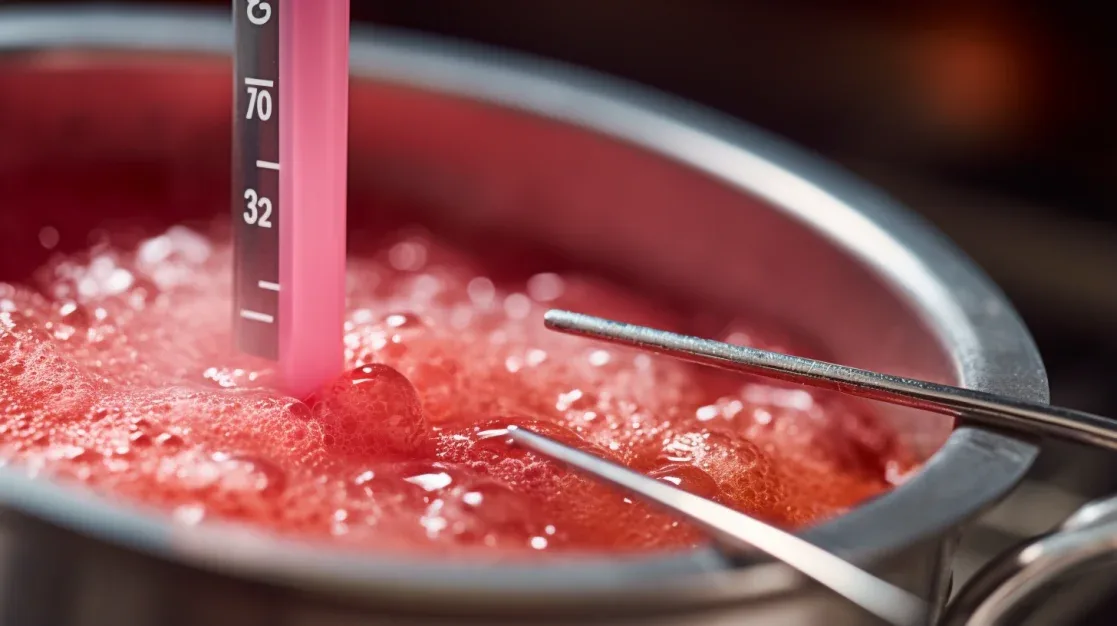Table of Contents
Do you have a sweet tooth but struggle with making candy at home? Look no further! In this article, we’ll explore the exciting world of kitchen hacks and dive into the question: can you use a meat thermometer for candy?
Discover the importance of using a candy thermometer, understand the differences between meat and candy thermometers, and learn how to ensure accuracy in your homemade sweets.
Get ready to elevate your confectionery skills with this handy kitchen hack!
Key Takeaways Of “Can You Use A Meat Thermometer For Candy”
- Candy thermometers ensure accurate and safe results in candy making.
- Meat thermometers may not accurately measure high candy-making temperatures and can lead to cross-contamination.
- Calibrating a meat thermometer properly is essential for accurate temperature readings.
- It is crucial to prioritize safety and accuracy using a candy thermometer or alternative candy-making methods.
What Is a Meat Thermometer?
A meat thermometer is a kitchen tool used to measure the internal temperature of the meat to ensure it is cooked to a safe level. It is a device that typically consists of a metal probe attached to a digital or analog display.
Meat thermometers are designed to accurately measure temperatures within a specific range, usually between 32°F and 212°F (0°C to 100°C). They are not explicitly calibrated for measuring higher temperatures needed for candy making.
While a meat thermometer may give you an approximate temperature reading for making candy, there are more accurate and reliable options than this one. Candy making often requires precise temperature measurements at specific stages, such as the softball or hard crack.
For accurate and reliable results when making candy, it is recommended to use a candy thermometer. Candy thermometers are designed to measure the high temperatures required for candy making, usually up to 400°F (200°C). They provide precise temperature readings to ensure your candies turn out perfectly every time.
Using a meat thermometer for candy making may not only give inaccurate temperature readings. Still, it can compromise food safety as meat thermometers may not be designed for extended exposure to high heat. It is always best to use the correct type of thermometer for your specific cooking needs.
Is It Safe and Accurate to Use a Meat Thermometer for Candy Making?
Using a meat thermometer for candy making is not recommended for several reasons. While meat thermometers are designed to accurately measure temperatures within a specific range, usually up to 212°F (100°C), they are not explicitly calibrated for the higher temperatures needed for candy making, which can reach up to 400°F (200°C).
Also, candy-making often requires precise temperature measurements at specific stages, such as softball or hard crack. Meat thermometers may need to provide the level of accuracy necessary for these stages, potentially leading to over or undercooked candies.
It is best to use a candy thermometer to ensure accurate and reliable results when making candy. Candy thermometers are designed to handle the high temperatures required for candy making and provide precise temperature readings. This ensures that your sweets turn out perfectly every time and minimizes the risk of undercooked or burnt treats.
Types of Thermometers

When it comes to cooking and baking, having an accurate thermometer is essential to ensure your food is perfectly cooked. Several types of thermometers are available for use in the kitchen, each with unique features and benefits.
- One of the most common types of thermometers is the analog thermometer. These traditional thermometers consist of a metal probe inserted into the food to measure its internal temperature. Analog thermometers are reliable and affordable options for everyday cooking tasks.
- Digital thermometers, on the other hand, offer higher accuracy and precision. These thermometers often come with a digital display showing real-time temperature readings. Digital thermometers are also available in different variations, such as instant-read and probe thermometers.
- Instant-read thermometers are perfect for quickly checking the internal temperature of meat, poultry, or fish. They provide accurate temperature readings in just a few seconds, making them ideal for busy kitchen environments.
- Probe thermometers, however, feature an extended probe that can be inserted into the food while cooking. These thermometers allow you to monitor the temperature of your food without opening the oven or grill, helping you achieve perfectly cooked meats and other dishes.
- Another type of thermometer commonly used in the kitchen is the candy thermometer. Candy making often requires precise temperature measurements at specific stages, such as the softball or hard crack. Candy thermometers are designed to have a wide temperature range and provide accurate readings for making sweet treats like caramel, fudge, and toffee.
It’s important to note that while meat thermometers can be used for candy making, they may need to provide the accuracy necessary for achieving the desired results. Meat thermometers typically have a narrower temperature range and may not be able to measure the temperatures required for candy-making accurately.
In conclusion, choosing a suitable thermometer for your cooking needs is essential for achieving the best culinary results. Analog and digital thermometers offer reliable temperature readings for everyday cooking tasks, while candy thermometers are designed to make sweet treats. So, whether you’re cooking meat, baking a cake, or making candy, having the correct type of thermometer in your kitchen arsenal will ensure your food is perfectly cooked.
The Importance of Using a Candy Thermometer
It would help if you always used a candy thermometer when making candy to ensure accurate and safe results.
The benefits of using a candy thermometer are numerous. Temperature plays a crucial role in the candy-making process; even slight variations can impact the final product. A candy thermometer allows you to monitor the temperature precisely, ensuring that your candies turn out perfectly every time.
It helps you achieve the desired consistency, whether soft caramels or a hard crack stage for lollipops. Additionally, using a candy thermometer ensures safety, as some recipes require reaching high temperatures that can cause burns if not handled properly.
Understanding the differences between meat and candy thermometers is essential to handling your candy-making journey smoothly.
Understanding the Differences Between Meat and Candy Thermometers

Knowing their specific uses and temperature ranges is essential to understand the differences between meat and candy thermometers. While both thermometers measure temperature, they are designed for different purposes. A meat thermometer is primarily used to check the internal temperature of cooked meats to ensure they are safe to eat. On the other hand, a candy thermometer is calibrated explicitly for making candies and other sweet treats. It allows you to accurately monitor the sugar syrup temperatures required for various candy-making stages, such as soft ball, hard crack, or caramelization.
Here is a comparison table highlighting the key differences between meat and candy thermometers:
| Thermometer | Temperature Range | Accuracy |
|---|---|---|
| Meat | 32°F – 212°F | ±2°F |
| Candy | 100°F – 400°F | ±1°F |
As you can see from the table above, candy thermometers have a wider temperature range compared to meat thermometers. Additionally, candy thermometers are more accurate due to their narrower degree increments.
When it comes to alternatives to using a meat thermometer for candy making, specialized digital candy thermometers offer even greater accuracy and ease of use. These digital options often come with features such as programmable temperature alarms and easy-to-read displays.
Transitioning into the next section about potential risks and safety concerns of using a meat thermometer for candy making…
Potential Risks and Safety Concerns of Using a Meat Thermometer for Candy Making
When using a meat thermometer for making candy, it’s essential to be aware of the potential risks and safety concerns involved. Here are some key points to consider:
- Risks of cross-contamination:
- Meat thermometers are designed for raw meats, which can harbor harmful bacteria.
- If used interchangeably for candy making, cross-contaminating the thermometer with bacteria from raw meats is risky.
- Limitations of meat thermometers:
- Meat thermometers may not have the temperature range to measure the high temperatures required for candy making accurately.
- They may also lack features specific to candy making, such as clip-on attachments or protective covers.
By understanding these risks and limitations, you can take appropriate precautions and make informed decisions when using a meat thermometer for candy making.
Now let’s explore some tips for ensuring accuracy when using a meat thermometer in this context.
Tips for Ensuring Accuracy When Using a Meat Thermometer for Candy Making
One way to ensure accuracy while using a meat thermometer for candy making is by calibrating it correctly. Calibrating your thermometer helps you achieve accurate temperature readings, which is crucial in candy-making. To calibrate your meat thermometer, follow these simple tips:
- Fill a glass with ice and add water until it’s filled.
- Insert your thermometer probe into the ice water without touching the sides or bottom of the glass.
- Wait for a few minutes until the reading stabilizes.
- Adjust the calibration nut on your thermometer to read 32°F (0°C).
By calibrating your meat thermometer regularly, you can trust that it will provide accurate readings when making candy.
Now let’s explore alternatives to using a meat thermometer for candy making that can come in handy in case you don’t have one or prefer other methods.
Alternatives to Using a Meat Thermometer for Candy Making
When making candy, it’s essential to prioritize safety and accuracy when using a candy thermometer.
In this discussion, we will explore the critical points of candy thermometer safety and the accuracy of alternative methods and weigh the pros and cons of each option.
Candy Thermometer Safety
Using a meat thermometer for candy-making can be safe and accurate. Here’s why:
- Safety:
- The meat thermometer is designed to withstand high temperatures, making it suitable for measuring hot sugar syrups.
- It has a long probe that keeps your hands away from the boiling mixture, minimizing the risk of burns.
- Accuracy:
- Meat thermometers are calibrated to provide precise temperature readings, ensuring your candy reaches the desired consistency.
- They come with clear temperature markings and easy-to-read dials or digital displays, allowing you to monitor the progress accurately.
Accuracy of Alternative Methods
Exploring alternative methods for measuring temperature accurately is essential to ensure your candies turn out perfectly. While candy thermometers are commonly used, other options can provide reliable results. Here are some alternative ways you can try:
| Method | Description | Pros |
|---|---|---|
| Water Test | Drop a spoonful of boiling syrup into cold water and observe its consistency. | Quick and easy to do with no special equipment required. |
| Thermocouple | Use a digital thermometer with a thin probe to measure the temperature of the syrup. | Provides precise readings and is versatile for other cooking tasks as well. |
| Infrared | Use an infrared thermometer to measure the surface temperature of the sugar mixture. | Non-contact method and gives instant readings. |
While these alternative methods may be convenient, it’s important to note that they may not be as accurate as dedicated candy thermometers. They can still provide helpful information but require some practice to achieve consistent results. Now let’s discuss the pros and cons of using meat thermometers for candy making without skipping a beat!
Pros and Cons?
The pros and cons of using alternative methods for measuring candy temperature are worth considering.
- On the one hand, alternative methods offer convenience and affordability.
- Using a toothpick to check the consistency of the candy allows you to assess its readiness visually.
- The cold water test involves dropping a small amount of hot syrup into cold water and observing its behavior.
However, these methods may need more accuracy and safety than a dedicated candy thermometer.
- Toothpicks can break or contaminate the candy with bacteria from your mouth.
- The cold water test can be subjective, leading to inconsistent results.
Regarding accuracy and safety in candy making, there may be better options than relying on a meat thermometer designed for higher temperatures.
The following section will explore final thoughts on using a meat thermometer for making candy without compromising taste or texture.
Frequently Asked Questions

Can I Use a Meat Thermometer for Candy?
While a meat thermometer could potentially be used for candy, it’s recommended to use a candy thermometer for precise results.
Can a Meat Thermometer Be Used for Candy?
Using a meat thermometer for candy may not work well due to varying temperature ranges.
Can I Use a Candy Thermometer on Meat?
A candy thermometer is designed for higher temperatures required for candy-making and may not be suitable for meat.
Can I Use a Regular Thermometer for Candy?
A regular thermometer might not accurately measure the high temperatures needed for candy-making.
Does a Meat Thermometer Work for Candy?
A meat thermometer might not be suitable for candy-making due to its temperature range limitations.
Can I Use a Digital Meat Thermometer for Candy?
Using a digital meat thermometer for candy might not provide precise temperature readings required for candy recipes.
Conclusion
Overall, using a meat thermometer for candy making may not be the safest or most accurate option. While it may seem convenient, there are potential risks and safety concerns.
To ensure accuracy, following tips such as calibrating the thermometer and testing it in boiling water is essential. However, alternatives, such as candy thermometers designed explicitly for this purpose, are available.
In conclusion, just like using a wrench to pound nails is not ideal, using a meat thermometer for candy-making may not provide the precision needed for successful results



